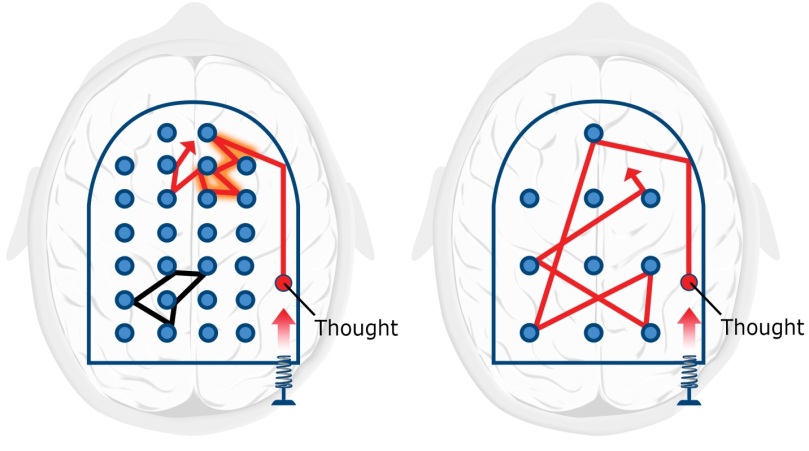So I completed this course on Coursera. It’s called Learning how to learn.

I am the kind of person who thinks that life is too short and there’s a lot to learn. So in this short span, if you try to learn things in an ineffective way, it is simply a waste of time. So I was searching for ways I could learn effectively. And that’s when I stumbled upon this amazing course delivered by University of California, San Diego.
I will try to summarize here, what I learned in the course so that you can take away the key points which are ready to be implemented in your own learning methodology. Of course, you can always enrol for this course on Coursera and learn the concepts in complete depth. Let’s get started.
Types of thinking:
Thinking can be broadly categorized into two types. Focused and diffused. Or it can be said that there are two learning modes. Focused mode and diffused mode.
Focused mode is the mode in which you are actively engaged in the learning process. This includes taking notes, trying to understand concepts, highlighting important points, and actively indulging in the process of understanding as well as retaining some concept. Focused mode is the mode where we learn new things and make new neural patterns. It can be called as active learning.
Diffused mode is the mode in which you are not actively engaged in the learning process. In this mode, the process of learning is carried out by your brain without you active participation. It is done when you are engaged in some unrelated activity like sleeping, exercising, or doing some totally unrelated stuff. While you are out there, away from the topic you were trying to learn, the brain tries to make the already acquired information more persistent. It tries to form new neural patterns and make the existing ones more permanent. This explains why it has happened to you that you were unable to work out a solution for a specific problem, but after revisiting the problem the next day, the solution just occurred to you out of the blue. This happened because while you were sleeping, your brain was working on the problem and trying to find out a solution by contacting other neural patterns and concepts that you might have studied in the past. It can be called as passive learning.
The pinball machine analogy:
In the course, the modes were explained with the help of a pinball machine analogy where the thought is the ball and the brain is the machine.
In focused mode, the rubber bumpers are close to each other and contain specific patterns within them. The thought that enters looks for an existing pattern and goes straight to the pattern to associate itself with it.
In diffused mode, the rubber bumpers are sparsely located and thus, it is easier for the thought to bump across them. Here, new initial patterns may be formed.
You cannot be in both the modes at the same time. They are like the sides of a coin. You can see only one at a time. Here is the representation. Focused mode on the left and diffused mode on the right.

Thomas Edison used diffused mode to come up with solutions to problems. He would let himself fall asleep while working on a problem with ball bearings in his hands. As he would fall asleep, the bearing would fall and the sound would wake him up. Most of the times, by the time he had woken up, he would have a solution to the problem or at least, a new approach or a new way to look at the problem.
Long term memory: It is the memory in which the things you already know reside. Like the languages you know, the knowledge about how to do things like driving a car, playing an instrument, etc. It can be thought of as a storage warehouse where information is dumped and can be retrieved at a later stage when needed. It is like a computer hard drive.
Short term memory: It is the memory in which the things you are currently learning reside. It can be thought of as a whiteboard which is not so clear to write. You write information on that board but in order to retain it, you need to make it darker by repetition. These can be selectively transferred to the long term memory. It is like the computer RAM.
Following are some approaches you can follow for an effective learning:
1) Take it slow:
Learning is analogous to body building. In the same was as you build and strengthen your muscles by working out daily, you need to strengthen your neural connections by working on them daily, on a regular basis. You cannot prepare for a weightlifting competition by trying to lift heavy weights one day before the competition. It simply won’t do. It will be useless at best and exhausting at worst. In the same way, you can’t cram up the knowledge at at once. It will be a waste of time an effort. In order to store the information in a meaningful way and be able to recall it at a later stage, it should be stored in a structured and organized manner. And this process takes time.
2) Pomodoro technique:
It is an effective technique for focused learning. It suggests that whenever you are trying to learn something new, set a timer for 25 minutes. And in those 25 minutes, pay undivided attention to the concept you are trying to learn. No distractions are allowed in those 25 minutes. Try to understand the topic you are reading. Try to make sense of the information. Then, after you are done, reward yourself with a treat. Read a book, go out for a walk, eat something you like, talk to a friend, etc. Then again, come back after an hour or so and concentrate for 25 minutes. This will allow you to learn more effectively.
3) Make analogies:
While you are in your focused mode, try to connect the concepts with existing concepts in your brain. Or even better, try to map them with real world concepts or objects. Analogies will help you store the newly learned information in an efficient and quick way.
4) Practice:
This sounds like a no-brainer but is is often the most neglected things new learners do. The newly acquired information is present in your brain as a weak, delicate neural structure. It needs to get more solid and permanent. It is like a light drawing on a black board. If it is not made darker, it will simply get washed away. Practice often helps in strengthening the pattern and make it more persistent. Don’t practice until you get it right. Practice until you can’t get it wrong. Only after you have completely understood a pattern and practised it numerous times, should you move on to a new topic.
5) Spaced repetition:
Instead of repeating a concept over and over in a single night, give it some time to assimilate in your memory. Instead, repeat it over the week, every single day. This way more structured learning can be done.
6) Understand what you are learning:
To learn something, try to get into the thick of it. Explore the depths of the concept. Ask yourself whether what you are learning is making sense to you or not. If in a lecture, ask questions. Try to question what is assumed. Have active discussions about the topic with colleagues. Active engagement is better than passive listening.
7) Learn by doing:
One of the best ways to learn something is by doing it. Convert it into a deliverable. For example, I learned how to learn and now I am writing this blog. This blog post is my deliverable. It will help others as well as myself if I ever need to refer it in future. The deliverable can be a piece of code, an article, an application, a Youtube video, or a discussion session with your colleagues.
8) Take a break or do something unrelated:
Taking a break lets your diffused mode be in charge. It organizes the newly formed connections and strengthens them. It also helps you get relaxed physically and mentally. Do something totally unrelated. It gives you a break and start afresh on the topic you’ve been stuck at. It helps generate new ideas. To remember ideas,take notes in your free time. If you can’t answer a question, skip it and come back later. You are more likely to answer it later. It helps you to look at things from a new perspective.
9) Exercise:
Contrary to the existing beliefs, new neurons can be generated even in adulthood in hippocampus. Having enriched environment makes the neuron connections grow. Active participation is important. Being among creative people helps in enhancing your own creativity. Listening to other’s creative ideas and telling them yours is an amazing way of coming up with more creative ideas.
10) Perseverance:
Success is not a product of smartness. It is a product of being passionate and persistent. Don’t give up. Nothing worth having comes easy. Same is true in case of knowledge. Everything is difficult initially for a beginner. As you progress, it becomes easier. Not giving up is the key.




